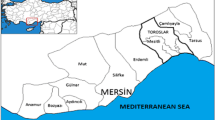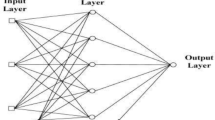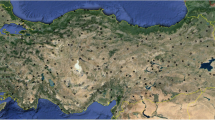Abstract
Soil temperature (T S) strongly influences a wide range of biotic and abiotic processes. As an alternative to direct measurement, indirect determination of T S from meteorological parameters has been the focus of attention of environmental researchers. The main purpose of this study was to estimate daily T S at six depths (5, 10, 20, 30, 50 and 100 cm) by using a multilayer perceptron (MLP) artificial neural network (ANN) model and a multivariate linear regression (MLR) method in an arid region of Iran. Mean daily meteorological parameters including air temperature (T a), solar radiation (R S), relative humidity (RH) and precipitation (P) were used as input data to the ANN and MLR models. The model results of the MLR model were compared to those of ANN. The accuracy of the predictions was evaluated by the correlation coefficient (r), the root mean-square error (RMSE) and the mean absolute error (MAE) between the measured and predicted T S values. The results showed that the ANN method forecasts were superior to the corresponding values obtained by the MLR model. The regression analysis indicated that T a, RH, R S and P were reasonably correlated with T S at various depths, but the most effective parameters influencing T S at different depths were T a and RH.






Similar content being viewed by others
References
Best MJ, Cox PM, Warrilow D (2005) Determining the optimal soil temperature scheme for atmospheric modelling applications. Bound-Lay Meteorol 114:111–142
Bond-Lamberty B, Wang C, Gower ST (2005) Spatiotemporal measurement and modeling of stand-level boreal forest soil temperatures. Agr Forest Meteorol 131:27–40
Gao Z, Bian L, Hu Y, Wang L, Fan J (2007) Determination of soil temperature in an arid region. J Arid Environ 71:157–168
George RK (2001) Prediction of soil temperature by using artificial neural networks algorithms. Nonlinear Anal 47:1737–1748
Holmes TRH, Owe M, De Jeu RAM, Kooi H (2008) Estimating the soil temperature profile from a single depth observation: a simple empirical heat flow solution. Water Resour Res 44:W02412. doi:10.1029/2007WR005994
Houle D, Duchesne L, Ouimet R, Paquin R, Meng FR, Arp PA (2002) Evaluation of FORHYM2 model for prediction of hydrologic fluxes and soil temperature at the Lake Clair Watershed (Duchesnay, Quebec). Forest Ecol Manag 159:249–260
Hu Z, Islam S (1995) Prediction of ground surface temperature and soil moisture content by the force-restore method. Water Resour Res 31(10):2531–2539
Jackson T, Mansfield K, Saafi M, Colman T, Romine P (2008) Measuring soil temperature and moisture using wireless MEMS sensors. Measurement 41:381–390
Lal R, Shukla MK (2004) Principles of soil physics. Marcel Dekker, Inc. New York, p 682
Landeras G, Ortiz-Barredo A, López JJ (2008) Comparison of artificial neural network models and empirical and semi-empirical equations for daily reference evapotranspiration estimation in the Basque Country (Northern Spain). Agr Water Manag 95:553–565
Lin JD (1980) On the force-restore method for prediction of ground surface temperature. J Geophys Res 85:3251–3254
Mihalakakou G (2002) On estimating soil surface temperature profiles. Energ Buildings 34:251–259
MO IRI (2007) Iranian meteorological office. Data Processing Center, Tehran
NeuroDimension, Inc. (2005) Developers of NeuroSolutions v5.01: Neural Network Simulator. Gainesville, FL. http:\\www.nd.com
NeuroSolutions (2003) The neural network simulation environment. NeuroDimension Inc., FL
Paul KI, Polglase PJ, Smethurst PJ, O’Connell AM, Carlyle CJ, Khanna PK (2004) Soil temperature under forests: a simple model for predicting soil temperature under a range of forest types. Agr Forest Meteorol 121:167–182
Plauborg F (2002) Simple model for 10 cm soil temperature in different soils with short grass. Eur J Agron 17:173–179
Sabziparvar AA (2009) Estimation of clear-sky effective erythema radiation from broadband solar radiation (300–3,000 nm) data in an arid climate. Int J Climatol 29(13):2027–2032
Seyfried MS, Flerchinger GN, Murdock MD, Hanson CL, Van Vactor S (2001) Long-term soil temperature database, Reynolds Creek Experimental Watershed, Idaho, United States. Water Resour Res 37(11):2843–2846
Tabari H, Marofi S, Sabziparvar AA (2010a) Estimation of daily pan evaporation using artificial neural network and multivariate non-linear regression. Irrig Sci 28:399–406
Tabari H, Marofi S, Zare Abyaneh H, Sharifi MR (2010b) Comparison of artificial neural network and combined models in estimating spatial distribution of snow depth and snow water equivalent in Samsami basin of Iran. Neural Comput Applic 19:625–635
Torres M, Hervas C, Amador F (2005) Approximating the sheep milk production curve through the use of artificial neural networks and genetic algorithms. Comput Oper Res 32:2653–2670
Zheng D, Raymond Hunt E Jr, Running SW (1993) A daily soil temperature model based on air temperature and precipitation for continental applications. Climate Res 2:183–191
Acknowledgments
We wish to express our gratitude to the anonymous reviewers whose suggestions and remarks have greatly helped us to improve the quality of the manuscript. The Islamic Republic of Iran Meteorological Organization (IRIMO) for providing the meteorological data is also acknowledged.
Author information
Authors and Affiliations
Corresponding author
Rights and permissions
About this article
Cite this article
Tabari, H., Sabziparvar, AA. & Ahmadi, M. Comparison of artificial neural network and multivariate linear regression methods for estimation of daily soil temperature in an arid region. Meteorol Atmos Phys 110, 135–142 (2011). https://doi.org/10.1007/s00703-010-0110-z
Received:
Accepted:
Published:
Issue Date:
DOI: https://doi.org/10.1007/s00703-010-0110-z




